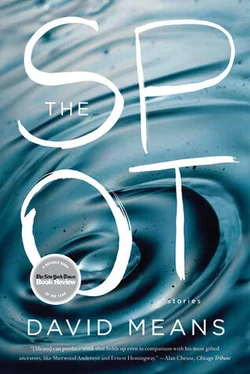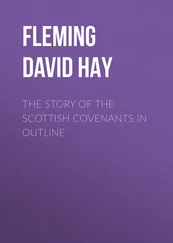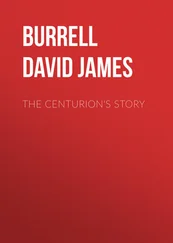
A quick glance back told me Donnie was doing his part, speaking out the side of his mouth — sans cigar — and holding his edge, adjusting himself quickly to the scene, making sure he had the upper hand on the Old Order Mennonite, while, in the back, Carson worked his role of bagman, took the counters, whispering his commands to tellers and bank officials in a low voice that drew them close, aching to hear, eager to get it right, and in turn allowed each of them a good look at the tommy gun, which he hefted in a certain way, cradling it against his hips. All in all — I thought — he was the perfect guy for the job and played the role to the hilt, bearing himself in a stately manner under the weight of responsibility that came from being the apex, the guy at the point of transference. Tall and lean, he moved like a movie star, all style, limberly urging folks with small, delicate nudges of the barrel, making improvised gestures, taking what he could as fast as he could, maintaining an absolute cool, speaking with that hayseed politeness, the kind that comes from feeling perpetually outclassed. He rarely lost his cool. When he did, it was usually in the form of a single shot to the head.
In the parlance of the profession she might be called a natural distraction factor. (Cops are an unnatural distraction factor, arriving creaky and stiff-jointed. Cops hobble in fearfully, all leather squeak and handcuff clatter.) A natural distraction factor appears as part of the everyday landscape: a white gull making lovely swooping motions in the sky (the Atlantic City Trust botch) or an unusual calico cat sleeping on the hood of a car (the North Dakota National Bank botch in Fargo), or a kid with a Pretty Boy Floyd face drinking a soda pop (the Fresno Botch/Massacre). Natural distraction factors draw the player — usually the door guy — away momentarily from the strict mechanics of the heist, creating not only a few beats of stark distraction but also a wider sense of perspective, reorienting the mind so that the player must, when he returns his attention to the job at hand, reconnect with the nature of his obligations in relation to the task. In this case the natural distraction factor appeared across the street, moving carefully, sashaying her hips against a tight red skirt, arms loaded with bags. Her hair was piled in a fantastic beehive of blond over her pale forehead as she stumbled in her high heels, just off balance enough to lend her an alluring vulnerability. She moved through attractive obliviousness as she struggled against her burdens, swinging those hips in easy gyrations.
Idea was to avoid the following:
The silent-alarm botch, in which case some trigger-happy teller takes pleasure in knowing that a posse of jazzed-up cops is roaring through the streets, eager to get to the scene but keeping the sirens off and trying to avoid wheel screeches, all because he fingered the button at the first sign of a stickup.
The mix-up botch, in which preplanned roles become fused so that, say, the bagman, in the head of the job, finds it necessary to help with the herding, and in so doing opens up, as it were, a force vacuum leading (perhaps) to a silent-alarm trigger botch, and/or:
A heroic fallacy botch, in which one soul stands firm, gathering strength of will from some deeper source — a profound latent rage, perhaps, formed from an overly dramatic sense of fairness — and, seeing the gun muzzle, staring deep into the heart of the bore, feels compelled to side with the idea of authority and thus internalizes the onus of the crime — as he sees it — to the point of active rage, which in turn gives him the strength to stand firm and to resist barked orders. (In a nonbotch scenario the hero’s vision is lost when he’s shot or pistol-whipped. In the nonbotch the intuitive abilities — or the connection to some higher law — is short-circuited by a flush of fear. In the nonbotch scenario the hero lifts his heels from the floor or has an annoying tic: One way or another, all good intent and God connections — in the nonbotch setup — fade when his brainpan is shattered, and he then slumps off with the rest of the customers.) Let it be noted that the botch situation can only, in retrospect, be fully understood in relation to the nonbotch possibilities. Therefore, there is a deeply sentimental aspect to the whole matter. Nothing is sadder than the examination of a crime gone awry. Insofar as these things go, a nonbotch scenario (resistant-hero type is shot in the nick of time) can shift to a botch (gunshots alert passerby, or create uncontrollable chaos situation in which the disorder supersedes the ability to forcefully instill order) on a dime. So the idea is to play the two sides against each other to create a harmony between the two potentials. Idea is to avoid second-guessing and to maintain focus on the job at hand: getting the money and fleeing the bank, hooting and hollering in jubilation at a fate avoided, lead-footing it out of town and into the spectacular monotony of the open road.
When I turned from the window that afternoon, after watching the woman with those bags — those ankle-hobbling high heels! the instability of her gait! the afternoon sky firm against the brick facades! — I strained to reorient myself to the heist. But my attention was snagged on that beautiful vision in the street. This led to a classic error. Let me say here that I’ll never admit, as some might, to a split in my attention. What transpired was the opposite, actually. The effort that it took to cast the natural distraction factor away (and I did cast her away!) served to sharpen the acuteness of my attention when I swung my gaze back to the interior, and I locked with too much intensity on the resistant factor: the Old School Mennonite refusing Donnie’s orders, holding his hands out not with his palms up, but rather with his palms down, lifting them up and down in defiance, as if he were trying to shoo something away. At that moment my obligation — working hard to unsnag myself from the vision in the street — was to stay steady and calm. The idea was to keep cool. But instead I only saw the Old Order Mennonite. I fixed on him and he felt me looking and turned to me and presented his face: lean, long, gaunt around the chin, with a bristle of beard and agate eyes, cold and stony, set beneath busy black brows, above which were deep furrows leading up to a knobby forehead that drove itself into the heavy felt of his black hat. The look he shot me was on equal terms with mine — hard, ruthless, and blunt.
Idea is to push the botch as far it can go, to rally the chaos into an escapable situation, to arrange the disorder into itself, to affirm the oft-repeated phrase — by Carson, mostly — that a good botch ends not with a bang, but with the whisper of shoe leather on pavement. So when Donnie shot the Old Order Mennonite, I shot him at exactly the same time. Then all hell broke loose. One of the tellers in the back began to break away, running forward, and Carson tagged him one in the back of the head. Another dashed to the side — pure panic, no motive, no real intent — and I unleashed one in her direction. Needless to say, the bullets flew. Nothing but the roar and saltpeter in the air and the echoes in the high reaches as we drove the madness into shape and were left with nothing but bags of cash — the two of us — and a persistent ringing in our ears.
Back at the forge the idea was to do a point-by-point analysis and to tweeze apart the boiling chaos, the plumes of blood, the rattle of the tommy gun until it jammed, the inaudible pleas that had draped around us, unheard in the roar. Idea was to find the exact point at which the potential for a botch (hidden in that stalemate between the Old Order Mennonite and Donnie) was somehow nudged over into a genuine bloodbath. Idea was to put aside the residual urgency of the aftermath — the gunmetal tartness on the tongue, the old iron stench of the forge, our sweat-caked shirts — and find something instructive in the mess, the educational moment, so to speak. Otherwise, it was just one more smear of carnage on the floor of one more Ohio bank. Otherwise, it was simply three men going into a rage and spilling blood. To break down the scenario, in retrospect, and to figure out just where the human element had slipped in to ruin what otherwise — up to that moment — had been a purely mechanistic situation: everything moving smoothly along the grand traditions. In most cases — Donnie was saying — you could shave it down to a single moment, freeze-frame it to the precise second just before all hell broke loose, and in doing so locate the blame in one of the following:
Читать дальше













